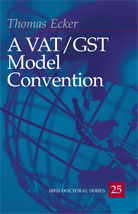| |
Pris: 1326 SEK exkl. moms  |  Given the increasing problem of double taxation concerning value added tax (VAT)/goods and services tax (GST) and the resulting constraints to international trade, it is time for the international community to take action. This book analyses the phenomenon of VAT/GST double taxation and possible remedies. VAT/GST treaties would be one of them. Given the increasing problem of double taxation concerning value added tax (VAT)/goods and services tax (GST) and the resulting constraints to international trade, it is time for the international community to take action. This book analyses the phenomenon of VAT/GST double taxation and possible remedies. VAT/GST treaties would be one of them.
But how should one design a VAT/GST treaty? To what extent do existing income tax treaties already apply to VAT/GST? Can income tax treaties simply be extended to VAT/GST or is there a need for a separate, independent VAT/GST treaty? Can the concepts, functioning, and structure of income tax treaties be used for VAT/GST purposes? What are possible alternatives? What should the scope of a VAT/GST treaty be? How can taxing rights be allocated between the parties to a treaty?
These questions are answered in this book, based on an in-depth analysis of the basic principles underlying VATs/GSTs; this analysis also provides the theoretical basis for policy decisions, especially on the allocation of VAT/GST taxing rights between contracting states. From the principles of the taxes, this book extracts criteria that a distributive rule should fulfil, all of which permits a structured assessment and evaluation of different options for distributive rules and their underlying place of taxation choice. Other topics that require consideration and that are discussed for purposes of a VAT/GST treaty are, for instance, the treatment of internal dealings, associated businesses, intermediaries, undisclosed agents and the consideration of input-taxed supplies (i.e. supplies that are exempt without a right for deduction of input VAT/GST).
This book strongly encourages international dialogue and effort in the coordination of national VAT/GST laws. If, however, coordination of unilateral measures fails to effectively prevent double taxation, states can take recourse to binding instruments into which they can build dispute resolution mechanisms – just as they do with respect to income taxes. This book provides a toolkit that may assist in the design of such an instrument and provides an example: a multilateral VAT/GST Model Convention. | | |
|